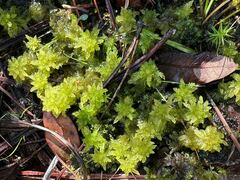Sphagnum lescurii
|
|
|
|
Family: Sphagnaceae
|
Plants moderate-sized to robust; upright, prostrate, or aquatic; green, pale yellow, golden brown, dark brown, tinged with red in exposed sites and purplish in aquatic forms; capitulum rounded and often strongly twisted. Stems pale green to brown, darker in aquatic forms; superficial cortex of 1 layer of enlarged, thin-walled cells. Stem leaves lingulate to ovate-lingulate, 1.3-2 mm; apex truncate to rounded, usually denticulate; hyaline cells typically fibrillose for 1/2 of leaf or more, often 1-2-septate, convex surface with 4-12 or more pores per cell along the commissures, concave surface with fewer pores. Branches usually curving, often large and tumid. Branch fascicles with 2(rarely 3) spreading and 1-2(-3) pendent branches. Branch leaves broadly ovate to ovate-lanceolate, 1.3-2.5 mm, greatly elongated in aquatic forms, straight or infrequently subsecund or subsquarrose; hyaline cells with 10-22 pores along the commissures on the convex surface, no or fewer pores per cell (1-8) on the concave surface. Sexual condition dioicous. Capsule exserted, with few pseudostomata. Spores 27-34 µm; finely papillose on both surfaces, with distinct raised Y-mark sculpture (indistinctly bifurcated Y-mark) on the distal surface; proximal laesura less than 0.5 spore radius. Weakly minerotrophic in a broad range of wetlands, often of an aquatic or periodically dried character; low to moderate elevations; Nfld. and Labr. (Nfld.), N.S.; Ala., Ark., Conn., Del., D.C., Fla., Ga., Ill., Ind., Iowa, Ky., La., Maine, Md., Mass., Mich., Minn., Miss., Mo., N.H., N.J., N.Y., N.C., Ohio, Okla., Pa., R.I., S.C., Tenn., Tex., Vt., Va., Wis., W.Va.; Europe. Sporophytes are uncommon in Sphagnum lescurii, which may be the most phenotypically variable of all the North American Sphagnum species, and quite probably deserves some taxonomic splitting. The tremendous phenotypic plasticity of this species, however, makes it quite difficult to sort out the genotypic component of variability, and thus most sphagnologists since Warnstorf have avoided the temptation of splitting and have instead treated this as one very variable species. This is the approach maintained in this treatment. We have also chosen not to use the earlier name S. denticulatum because its type is a phenotypic morphotype not clearly assignable to the current concept of either S. auriculatum or S. lescurii (K. I. Flatberg, pers. comm.). Some of the American material assignable to S. lescurii is quite likely the same as the European species S. auriculatum, but much of our material is certainly not the same. Until more definitive data are available, we have chosen to continue to use the name S. lescurii. The large stem leaf will generally distinguish this from similar species of sect. Subsecunda. See also discussion under 55. S. inundatum and 61. S. platyphyllum. The names Sphagnum alabamae Warnstorf, S. aquatile Warnstorf, S. obesum (Wilson) Warnstorf, S. rufescens (Nees & Hornschuch) Warnstorf, and S. turgidulum Warnstorf also have been applied to this taxon.
|








































